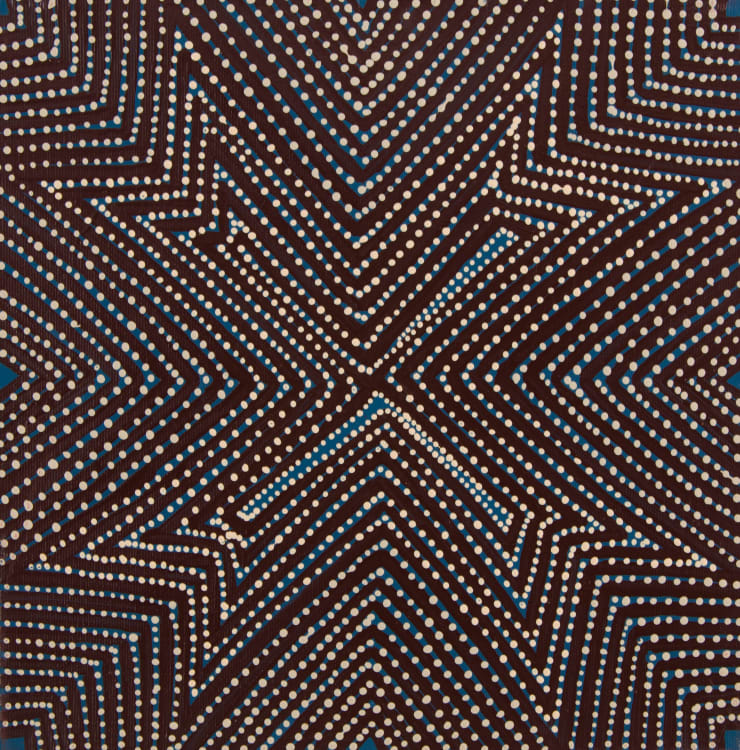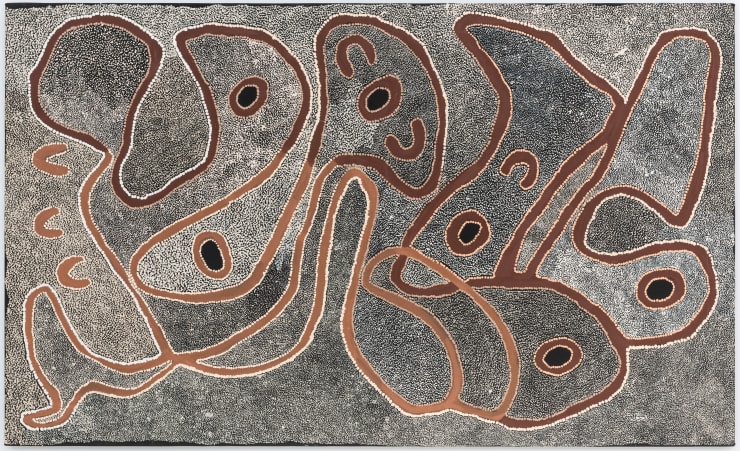Papunya Tjupi
Candy Nelson Nakamarra, Narlie Nelson Nakamarra, Mary Roberts Nakamarra, Isobel Gorey Nambajimba, Tilau Nangala, Maureen Poulson Napangardi, Emily Andy Napaltjarri, Charlotte Phillipus Napurrula, Patricia Phillipus Napurrula, Doris Bush Nungarrayi, Alice Napangardi Poulson, Janet Tjitayi
PAPUNYA - AN IMPORTANT PLACE IN THE HISTORY OF CONTEMPORARY INDIGENOUS ART
The Contemporary Aboriginal Art Movement had its controversial beginnings more than 40 years ago in Papunya, then an impoverished government settlement, 260 kilometres northwest of Alice Springs, in the Northern Territory state of Australia. In 1971, through sheer determination of the Papunya schoolteacher Geoffrey Bardon and a group of male artists, including Kaapa Tjampitjinpa, Tim Leura Tjapaltjarri, Turkey Tolson Tjupurrula, Uta Uta Tjangala, Clifford Possum and Billy Stockman (to name just a few) together implemented the beginning of an extraordinary art movement. This is an amazing story of determination, cultural tradition and art making.
Vivien Johnson, an historian and Western Desert art expert says in her book, *Streets of Papunya, The Re-invention of Papunya Painting "It was the sheer brilliance of the paintings these artists produced in the so-called seminal era - and beyond it - that liberated Aboriginal art from the timeless realm of ethnographic museums to take its place in art museums as part of contemporary art."
I have met many of the contemporary artists painting at the Papunya Tjupi art centre today initially led by the extraordinary rst managers Kasumi Ejiri and Simon Taylor, who demonstrated an indomitable pioneering spirit and 24/7 dedication. Towards the end of their rst year, working with artists in a temporary space, a house known as Lot 282, Papunya Tjupi found itself homeless. The managers were in crisis, with nowhere to live and nowhere for artists to paint. After much hard work; numerous grant applications and letters with a degree of success, the old Papunya Garage was eventually transformed into a new art centre and Kasumi and Simon scrubbed and cleaned the old Papunya artists house and moved in. Brilliant managers, Kasumi and Simon, both artists themselves, transformed the painting style of Papunya artists, who were initially producing mainly tourist work. The two managers slowly convinced the leading women painters to make only the highest quality works. Ejiri explains that their mantra was "slow". Both she and Simon encouraged slow, good painting; Kasumi said, " We tried to explain that it shouldn't be our objective to make the most paintings possible, but to make the best paintings possible."
Papunya Tjupi artists were quick to understand the bene t of individual style and a "new way of painting" so the best artists quickly won the day with extraordinary work you see today in their first major London exhibition at JGM Gallery. JGM Art first exhibited a group of Papunya Tjupi artists' work 8 years ago at the prestigious Masterpiece Fair in London, (Royal Hospital Chelsea,). British and European collectors instantly loved and understood the intricate patterns and controlled palette of the Papunya paintings and works have found a place in important collections in the UK, Europe and USA.
Initially engaging with this work in Australia many years ago, I was astonished by the depth of beauty, integrity and power of each painting. Papunya Tjupi artists, predominantly women, are strong characters and forged ahead with good management to achieve the international acclaim they enjoy today. Through JGM ART and JGM Gallery, we have sold a great number of paintings by Doris Bush Nungarrayi, Mary Roberts Nakamarra, Maureen Poulson and Beyula Putungka Napanangka to name just a few. We are very excited to showcase these outstanding works from Papunya Tjupi for our inaugural exhibition of 2018.
- Jennifer Guerrini Maraldi
-
 Candy Nelson Nakamara, Kalipinypa
Candy Nelson Nakamara, Kalipinypa -
 Maureen Poulson Napangardi , Kapi Tjukurrpa-Kalipinya
Maureen Poulson Napangardi , Kapi Tjukurrpa-Kalipinya -
 Maureen Poulson Napangardi , Kapi Tjukurrpa - Kalipinypa
Maureen Poulson Napangardi , Kapi Tjukurrpa - Kalipinypa -
 Maureen Poulson Napangardi , Kalipynypa Tjukurrpa
Maureen Poulson Napangardi , Kalipynypa Tjukurrpa -
 Maureen Poulson Napangardi , Kapi Tjukurrpa - Kalipinypa, 2016
Maureen Poulson Napangardi , Kapi Tjukurrpa - Kalipinypa, 2016 -
 Emily Andy Napaltjarri, Janmarda
Emily Andy Napaltjarri, Janmarda -
 Emily Andy Napaltjarri, Janmarda
Emily Andy Napaltjarri, Janmarda -
 Doris Bush Nungarrayi, Papa Tjukurrpa - Nyumannu, 2016
Doris Bush Nungarrayi, Papa Tjukurrpa - Nyumannu, 2016 -
 Tilau Nangala, Mikantji
Tilau Nangala, Mikantji -
 Tilau Nangala, Mikantji
Tilau Nangala, Mikantji -
 Tilau Nangala, Mikantji, 2016
Tilau Nangala, Mikantji, 2016 -
 Tilau Nangala, Mikantji
Tilau Nangala, Mikantji


















